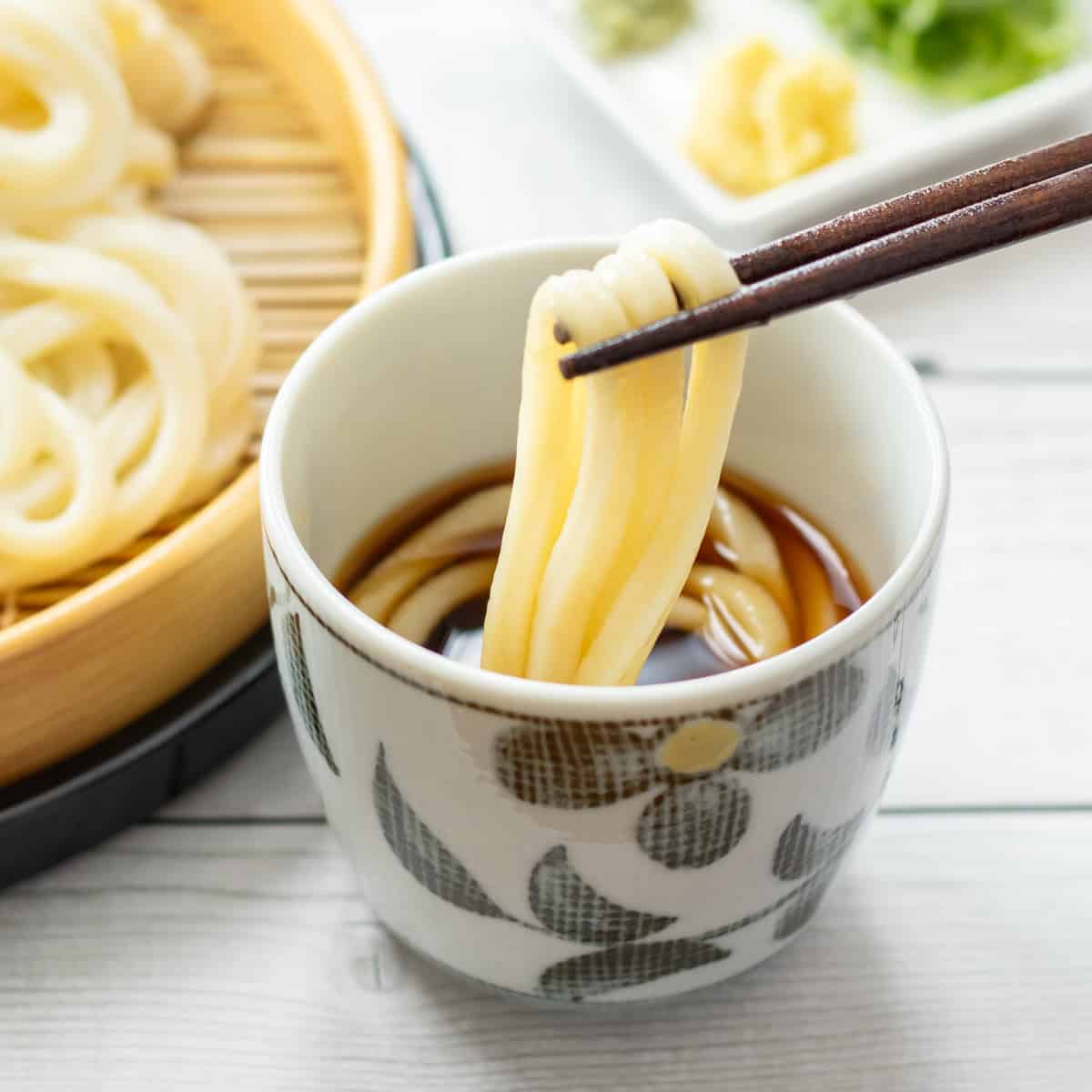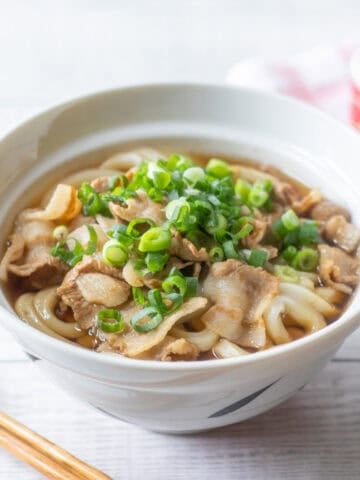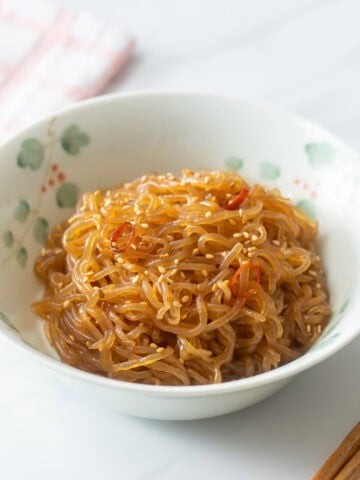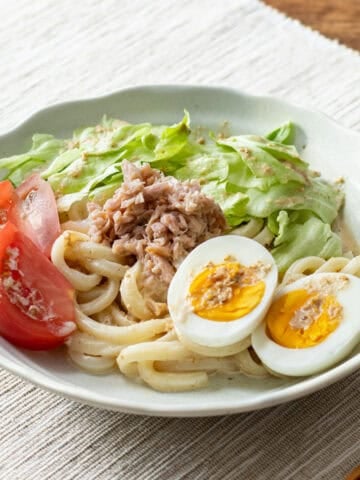Zaru Udon is a popular Japanese dish consisting of cold udon noodles served with a savory, dashi-based dipping sauce. The refreshing flavor and smooth, satisfying texture of the noodles provide a unique experience compared to typical udon noodle soup.

Jump to:
What is Zaru Udon?
Zaru Udon is a dish made by cooking udon noodles and then cooling them in cold water. It is enjoyed by dipping the noodles into a chilled, savory, and slightly sweet sauce. The term "Zaru" comes from the bamboo strainer traditionally used to serve noodles in Japan.
When it comes to udon dishes, you might picture a hot noodle soup, but this cold version served with a dipping sauce is also a staple in Japan, especially popular during the warmer months.
What makes this dish special is its simplicity, allowing you to fully enjoy the satisfying texture of the udon noodles. By chilling the noodles, you can appreciate their smooth and chewy texture—something that is less noticeable in hot udon dishes. A quick dip into the umami-packed sauce is enough to coat the noodles with plenty of flavor, so you won’t feel like anything is missing.
Although this dish is beloved in Japan, it is still not very well-known outside of the country even today in 2025, which I find a bit disappointing. Even at international Japanese udon chains like Marugame Udon, zaru udon is rarely found on the menu (even though it is a staple at udon shops in Japan).
So, if you enjoy this dish, I’d love for you to share this way of eating udon with your friends. Dipping udon noodles into sauce might seem new to you, but it is a very common practice in Japan. There is no complicated cooking process involved, so feel free to give it a try.

How to prepare the dipping sauce
An essential part of enjoying this dish is the dipping sauce.
This savory, slightly sweet, dashi-based sauce perfectly complements the taste of the noodles. This dipping sauce has a traditional flavor profile and is made with the following ingredients:
- Dashi stock
- Mirin
- Soy sauce
- Sugar
These ingredients are simmered to develop a mellow flavor, then chilled in the refrigerator until ready to serve.
While the type of dashi and the ratio of the ingredients vary depending on personal preferences, the ingredients themselves rarely change. Therefore, when talking about the dipping sauce for zaru udon, most Japanese people associate it with the flavor created by these ingredients.
There are two key points to keep in mind when making this sauce.
The first is the concentration of flavor. Zaru udon is a dish in which udon noodles are dipped into a sauce. If you prepare the sauce with the same concentration as you would for a typical udon noodle soup, the flavor won’t cling to the noodles properly, resulting in a bland taste. To avoid this, you should keep the amount of seasoning the same, but reduce the amount of dashi compared to udon noodle soup, so that the dipping sauce has a strong flavor when tasted on its own.
The second key point is the use of sugar.
Sugar is generally not used in udon noodle soup. On the other hand, for zaru udon, sugar plays a crucial role in balancing the flavors. Since both the noodles and dipping sauce are served cold, the flavor of the dashi doesn't stand out as much, so the dipping sauce needs to have a more pronounced taste.
The addition of sugar creates a perfect balance with the saltiness of the soy sauce and the umami of the dashi. This sweet-and-salty balance enhances the cold noodles and makes them more appetizing.
By following my recipe, you can easily prepare this dipping sauce. The sauce made with homemade dashi is authentic and delicious. That said, there is also an easier way to prepare the dipping sauce.
If you have store-bought mentsuyu (Japanese noodle soup base), you can use that instead. Depending on the product, you can use it as is or dilute it with water before serving. Either way, making the dipping sauce takes almost no effort.
If you're aiming for an authentic taste or don’t have access to mentsuyu, follow the recipe to prepare your dipping sauce. If you want to enjoy it casually, use store-bought mentsuyu.
Condiment options
When enjoying zaru udon, you can add condiments to the dipping sauce to subtly change its flavor. Common condiments served with this dish include:
- Chopped green onions
- Sesame seeds
- Shredded nori seaweed
- Tenkasu (tempura bits)
- Wasabi
- Grated ginger
- Grated daikon radish
These condiments are served on the side, rather than being mixed into the dipping sauce beforehand. This allows each person to adjust the sauce to their taste by adding the amount and type of condiments they prefer (though nori is sometimes placed on top of the udon noodles in advance). Even if you plan to try these condiments, it is best to first enjoy the dipping sauce on its own, and then experiment by adding condiments to change the flavor.
Since condiments are added according to personal preference, you can skip them entirely or add as many as you like. Try experimenting with a few and find your favorite combination.

📋Step-by-step recipe
Ingredients
- 2 servings udon noodles (fresh, dried, pre-cooked, or frozen)
Dipping sauce:
- ⅖ cup dashi stock (Please refer to the linked page for instructions on how to make it. For plant-based options, see the pages on Kombu Dashi and Shiitake Dashi.)
- ½ Tbsp mirin
- 1 ½ Tbsp soy sauce
- 1 tsp sugar
Condiments (optional, add to taste):
- chopped green onions / scallions
- toasted sesame seeds
- shredded nori seaweed
- tenkasu (tempura bits)
- wasabi paste
- grated ginger
- grated daikon radish
Instructions
🕒 Total: 40 minsIf you are using store-bought mentsuyu (a Japanese noodle soup base), you can start from step 2.

Step 1
Combine the ingredients for the dipping sauce (dashi stock, mirin, soy sauce, and sugar) in a pot and bring it to a boil over medium heat. Once boiling, reduce the heat to low and let it simmer for about 30 seconds before removing it from the heat. After it cools down, transfer the sauce to a container (or leave it in the pot) and chill it in the refrigerator.

Step 2
If using fresh, dried, or pre-cooked udon noodles: Boil the udon noodles according to the package instructions.
If using frozen udon noodles: Lightly sprinkle water over the udon noodles. Then, place them on a microwave-safe plate, cover with plastic wrap or a microwave-safe lid, and microwave on medium power (500-600W) for 3.5 to 4 minutes, or until heated through. (Since this method can cause uneven heating, it is best to microwave one serving at a time. You can also boil them like the other types of udon noodles.)

Step 3
Drain the noodles in a colander, then rinse them under running water or submerge them in ice water to cool them. Once cooled, drain off any excess water.

Step 4
Place a dish or tray under the strainer to catch any water dripping from the noodles. Fill small serving bowls with the chilled dipping sauce. Arrange the condiments on a separate plate based on personal preferences.
To store
This dish is not suitable for storage (although it remains edible), as moisture evaporates from the udon noodles, causing them to become dry and sticky over time. For the best texture, it is recommended to enjoy the dish as soon as possible. However, the dipping sauce itself can be stored for up to 3 days.
How to eat Zaru Udon
For those who are unfamiliar with the style of eating udon noodles with dipping sauce, here's a guide on how to enjoy zaru udon. Follow these steps:
- Hold your chopsticks with your dominant hand and the bowl of dipping sauce with the other hand.
- Pick up a small bundle of udon noodles with your chopsticks and dip them into the sauce.
- While bringing the bowl closer to your mouth, lift the noodles and eat them.
Keep holding the noodles with your chopsticks throughout the process. Since the dipping sauce has a strong flavor, a quick dip is enough to coat the noodles. If you would like to enjoy more of the udon’s natural flavor, you can dip only about 70-90% of the noodles into the sauce, leaving the remaining portion undipped.
While enjoying this dish, avoid drinking the dipping sauce directly. After finishing the noodles, some sauce will remain in your bowl, which should be discarded. It is not recommended to drink it due to its high salt content.
If you're having a second helping of udon noodles, you can continue using the same dipping sauce in your bowl. However, keep in mind that with each refill, the sauce may become diluted as the moisture clinging to the noodles mixes in.
Serving Zaru Udon
Some people might have noticed the container placed under the udon noodles in the recipe photo and wondered what it is. This is called a seiro, a traditional bamboo tray often used in Japan to serve cold udon or soba noodles.
The main reasons for using this tray are its cool, refreshing appearance and its connection to traditional practices. While it is sometimes even used at home for zaru udon in Japan, there is no need for you to go out and get one just to try this dish. As shown in the photo below, a regular strainer and a plate to catch the water dripping from the noodles are all you need.
I often use this style when eating zaru udon by myself. It is easier to clean up. Feel free to enjoy it your own way.

If you try this recipe, I’d love to hear what you think. Please consider leaving a review and star rating in the comments below. If you enjoyed it, I’d really appreciate it if you shared it with your friends.
Another cold udon noodle recipe you'll love
Recipe card

Zaru Udon (Cold Udon Noodles with Dipping Sauce)
Ingredients
- 2 servings udon noodles (fresh, dried, pre-cooked, or frozen)
Dipping sauce:
- ⅖ cup dashi stock (Please refer to the linked page for instructions on how to make it. For plant-based options, see the pages on Kombu Dashi and Shiitake Dashi.)
- ½ Tbsp mirin
- 1 ½ Tbsp soy sauce
- 1 tsp sugar
Condiments (optional, add to taste):
- chopped green onions / scallions
- toasted sesame seeds
- shredded nori seaweed
- tenkasu (tempura bits)
- wasabi paste
- grated ginger
- grated daikon radish
Instructions
- Combine the ingredients for the dipping sauce (dashi stock, mirin, soy sauce, and sugar) in a pot and bring it to a boil over medium heat. Once boiling, reduce the heat to low and let it simmer for about 30 seconds before removing it from the heat. After it cools down, transfer the sauce to a container (or leave it in the pot) and chill it in the refrigerator.
- If using fresh, dried, or pre-cooked udon noodles: Boil the udon noodles according to the package instructions.If using frozen udon noodles: Lightly sprinkle water over the udon noodles. Then, place them on a microwave-safe plate, cover with plastic wrap or a microwave-safe lid, and microwave on medium power (500-600W) for 3.5 to 4 minutes, or until heated through. (Since this method can cause uneven heating, it is best to microwave one serving at a time. You can also boil them like the other types of udon noodles.)
- Drain the noodles in a colander, then rinse them under running water or submerge them in ice water to cool them. Once cooled, drain off any excess water.
- Place a dish or tray under the strainer to catch any water dripping from the noodles. Fill small serving bowls with the chilled dipping sauce. Arrange the condiments on a separate plate based on personal preferences.
Notes
- If you're using store-bought mentsuyu (a Japanese noodle soup base), you can start from step 2.
- This dish is not suitable for storage (although it remains edible), as moisture evaporates from the udon noodles, causing them to become dry and sticky over time. For the best texture, it is recommended to enjoy the dish as soon as possible. However, the dipping sauce itself can be stored for up to 3 days.









Leave a Rating and a Comment